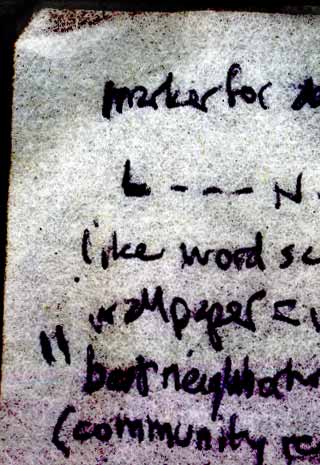The Cleveland AIGA brought Sheila Levrant deBretteville to town tonite, and for me it was a chance to meet someone who has a big place in my personal history. During the meeting I scribbled a few notes on a napkin, which when scanned became a lovely piece of texture, better than the notes themselves.
At the 1970 International Design Conference at Aspen, which I attended, Sheila gave away a promo piece for the Design program at Cal Arts, back when the college was still an idea. Didn't even have a campus yet.
The piece featured a pinecone, a piece of printed circuit, and a child's jack, all shrink-wrapped to a yellow cardboard rectangle. The text, in red Helvetica, talked about the role of the designer in society, ending with "taste and style aren't enough."
Those words stuck with me for the rest of my life. They became my viewpoint as a designer, and led me to focus on working with non-profit social change groups for the first 10 years of my career. No "workin' for the man" for me. Thanks, Sheila.
 The
napkin wasn't very easy to write on. My pen didn't want to cooperate, and
it was dark in the room. My notes aren't particularly interesting, but the
way the scan of the napkin turned out makes me glad I did it.
The
napkin wasn't very easy to write on. My pen didn't want to cooperate, and
it was dark in the room. My notes aren't particularly interesting, but the
way the scan of the napkin turned out makes me glad I did it.
The texture of the flimsy napkin is revealed by the harsh light of the scanner, and some color gets introduced in the shadow areas as well. It's actually not a very accurate scan, since the napkin is white and the writing is sort of grayish in reality, But I like this version better than the real thing.
As it turned out, Sheila showed a picture of a public art project she's finishing up in Boston ("best neighborhood" near bottom of notes). We saw the huge (6' tall, maybe?) cst into the concrete of a highway overpass. The full line is "Best neighborhood this side of Heaven." I remember remarking to Joanne that I thought that was a bunch of BS.
I'd have felt differently if I'd have known that this refers to the old working class neighborhood that was destroyed and replaced by a high-class middle-income development. Sort of like Ohio City.
Sheila's project tries to create a permanent memory of what used to be there. Besides the letters on the overpass, there are multiple smaller pieces to be installed nearby that provide more information of people who used to live in that neighborhood.